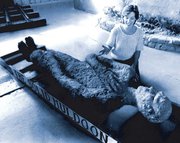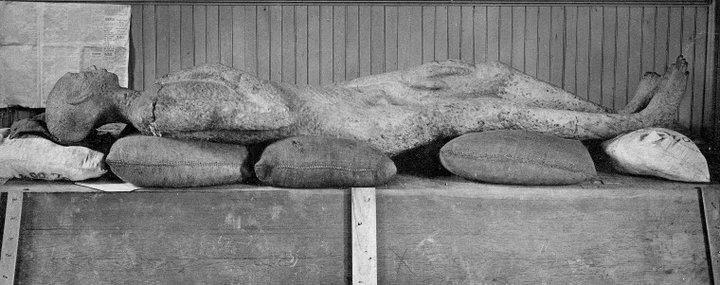Puebloan’s confounded by Giant Ancient Man
The 7 1/2-foot sculpture, excavated on the Beulah Road in 1877
and shown to crowds at a livery stable in Pueblo, had overly long arms and a short tail,
Puebloan’s Puebloan’s Puebloan’s Puebloan’s
both claimed as evidence of distant ape-to-human lineage.(even though it was 7.5 feet tall???)
The man appeared to be petrified
. . . (however it was incorrectly stated): ” had been shaped from pulverized rock and bone, plaster, blood and meat, and baked for two weeks in a kiln”. . . . . (unlikely!)
Puebloans thought it resembled an ancient Egyptian, an American Indian, an “Asiatic type,” but it actually hailed from Elkland, Pa.,
(however it was incorrectly stated): ” it actually hailed from Elkland, Pa., was shipped here by train and then buried in an area that had yielded fossils.
(Another unlikely claim was that): . . . it ” had an older brother of sorts, the Cardiff Giant, which was an earlier hoax executed by the clever but unscrupulous George Hull.” (George Hull must be burying these things around the world).
The Colorado Giant, or Solid Muldoon as it was christened soon after discovery, appeared to mixed reviews. Some thought it smelled fishy and others were sure it was real. The Pueblo Chieftain stated there was “considerable excitement” in the stable where it was displayed and that viewers wanted the opinion of a scientist on “the curious work of art.” The Chieftain suggested that master showman P.T. Barnum, who was in Denver at the time, come to Pueblo and render an opinion.
 “There can be no question about the genuineness of this piece of statuary,” read a Chieftain article of Sept. 19, 1877.
“There can be no question about the genuineness of this piece of statuary,” read a Chieftain article of Sept. 19, 1877.
“The stone shows the effects of time and the circumstances of discovery are such as to preclude” ( it to be genuine)
A few days later, on Sept. 22, the Chieftain called (the cavity fill) “a wonder of the world”
while noting confusion in viewers’ minds as to whether the “apparent petrification . . . is a preAdamite, . . .(preflood) or one of the more recent stages of antiquity.”
The Beulah Historical Society’s “From Mace’s Hole, The Way It Was, To Beulah, The Way It Is” offers a detailed account of the Solid Muldoon, in a chapter researched and written by Walter Wyant.
. . . . ” he decided to create another hoax,without review) this one based on his interpretation of the evolutionary “missing link.” (Wow! I am having a hard time seeing 7.5 feet missing links to man)
W.A. Conant of Colorado Springs, “found” it on Sept. 16, 1877, about 25 miles west of Pueblo on the road to Beulah and, with help, transported it to Pueblo.
Word of the amazing discovery was spread far and wide by Conant’s son, part-owner of a Colorado Springs newspaper. After it left Pueblo, the Muldoon was shown to crowds in Colorado Springs, Denver, Cheyenne, Wyo., and points eastward, and reached New York City by early November 1877.
Proof that the Muldoon was a fake came when one of Hull’s early partners realized he’d probably never see any of the money he’d been promised for the scheme, or even have his debts paid, and spilled the story to a New York newspaper reporter. The story was reprinted across the country and, though it surprised many people, it provoked little hostility, according to Wyant’s account.
“It was as if the circus had come to town and passed on. The public regarded a humbug as entertainment and seemed to enjoy the whole event,” Wyant wrote.
Madupe Labode, in the September 2003 edition of Colorado History Now, wrote about the Solid Muldoon: “Viewing the unusual and bizarre was a common pastime for nineteenth-century Americans, and the veracity of the object was almost beside the point. Pueblo’s bars served Muldoon punch and would-be poets wrote doggerel imploring the giant to reveal its secrets. The spectacle was a diversion from weightier events . . .”
The Solid Muldoon, according to Wyant, disappeared without a trace. However, a century later, the Colorado State Fair commissioned Pueblo artist Joel Carpenter to recreate the Muldoon.
His replica was made from iron beams, molded stucco wire and plaster and he worked from photos of the original. Carpenter’s model wasn’t shown at the Fair but was displayed at El Pueblo Museum before being given a proper burial in the late 1980s by the Beulah Historical Society. The Muldoon was waked with Irish music and laid to rest near the site of the original discovery.
At least that’s how the story goes . . .
— Sources include Pueblo Chieftain articles; September 2003 edition of Colorado History Now; and “Muldoon,” chapter 7 in “From Mace’s Hole, The Way It Was, to Beulah, The Way It Is,” by Walter Wyant.
So. . . . there has been at least 4 of these giants from cavity fills.
- The Traincar giant
- The Cardiff Giant
- The Pueblo giant
- Joel Carpenter recreation
Posted: Sunday, May 23, 2010 12:00 am | Updated: 11:18 pm, Sat May 22, 2010. Puebloans confounded by ancient ‘man’ By MARY JEAN PORTER | maryp@chieftain.com The Pueblo Chieftain |
by Greater Ancestors World Museum on Sunday, August 14, 2011 at 9:25pm

Comment